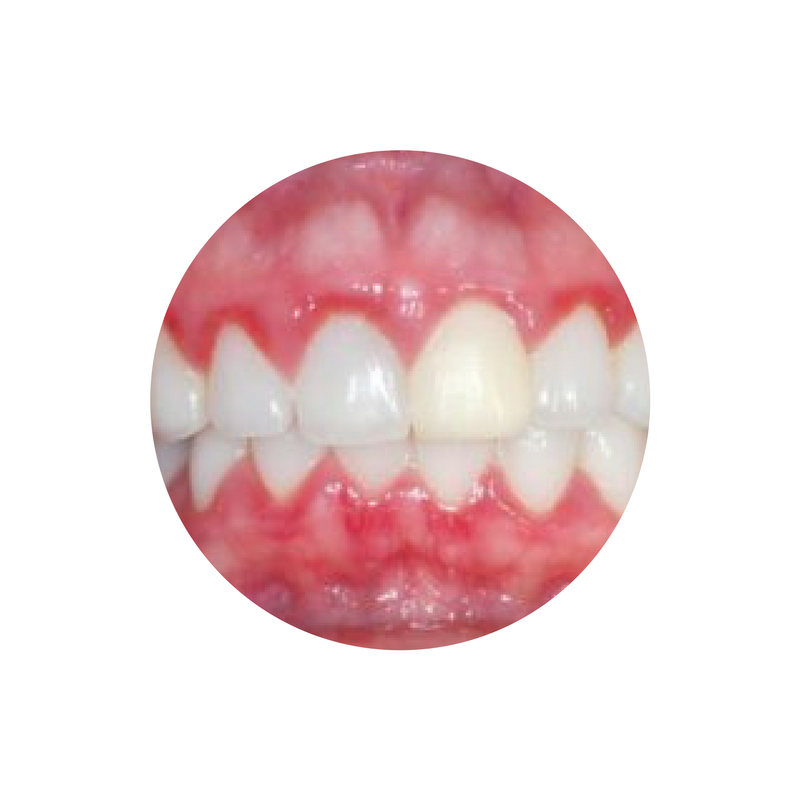What Is Mouth Breathing?
The mouth is for eating. The nose is for breathing. You wouldn’t ever stick a french fry in your nose, would you? The same can be said for taking air in through your mouth. It’s all wrong!
Mouth breathing is not how nature intended for us to breathe. Sure, there are times in which we are required to breathe out of our mouths, but they should really be limited to exercising or short periods when you are sick with a cold.
When you breathe through your mouth, you are
Changing the resting position of your tongue
By breathing through your mouth, you are forcing your tongue into a less-than-optimal position. Mouth breathing causes the tongue to rest low in the mouth, impacting development, breathing, swallowing, and more.
Not getting nitric oxide.
Nitric oxide is found in your sinuses, so when you nasal breathe, you get the incredible benefits of nitric oxide. Nitric oxide helps remove harmful bacteria and viruses, improve the immune system, regulate blood pressure, and improve oxygen uptake. (I wrote a blog about this. Read 3 Things You Should Know About Nitric Oxide.)
Getting less oxygen.
When you breathe through your mouth, it interferes with the oxygen absorption. Over time this causes you to need to breathe more frequently to get enough oxygen. Bonus—when you breathe through your nose, your little nose hairs act as filters and remove almost all of the bad stuff, bacteria and allergens!
Chronically stimulating the sympathetic “fight or flight” response
Inhaling and exhaling through the mouth is for emergency use only. It is a very shallow form of breathing and gets little help from the diaphragm muscle. This shallow breathing means that air is only exchanged in the upper lobes of the lungs. This is known as the “fight or flight” response.
You are probably not breathing with your diaphragm.
Oftentimes, people do not fully utilize their diaphragm to inflate their belly when mouth breathing. Diaphragmatic breathing is slow and relaxed breathing; mouth breathing is rapid, stressed breathing.
Altering the craniofacial growth of your face and how you look.
Mouth breathing and, more importantly, improper tongue posture harms craniofacial development. We often see underdeveloped jaws, a retracted chin, crooked teeth, or a long narrow face.
Mouth breathing is one of the unhealthiest habits that you can be doing.
Read the Ultimate Guide to Breathing
Mouth Breathing Wreaks Havoc In Many Areas

Teeth
Your lips and tongue are nature’s braces. They both serve a function to help guide your teeth into proper position and to keep them there. The tongue provides support from the inside and the lips from the outside. When mouth breathing occurs, both the lips and tongue are not in the proper position to properly support the teeth and malposition (crowding) can occur.

Gum Tissue
When you breathe with your mouth open, the delicate gum tissue becomes red, inflamed and painful. This is a very viscous cycle because it is often uncomfortable to brush well along the gum-line thus more plaque buildup. When the mouth is dry from mouth breathing the plaque becomes thicker and the irritation of the gum tissue results in a red line along the gum-line near the base of the tooth. This redness indicates that the gum tissue is unhealthy.
It was once considered to be something a person just accepted, however with adequate myofunctional therapy, this habit can be corrected and proper nasal breathing can be achieved. This results in healthy oral tissue and no bleeding and pain when brushing and flossing.

Periodontal Disease
In addition to the concerns shown on the tab under gum disease, the concern with mouth breathing extends to the development of periodontal disease. When gum tissue is irritated and heavy plaque buildup is evident along the gum-line, that plaque eventually mineralizes into calculus (or tartar) and migrates down beneath the gum surface. This progression of the disease is often silent but causes significant damage to the supportive structures of the teeth.
In addition to excellent home care and oral hygiene, myofunctional therapy can help correct the habits of mouth breathing so that tissue health can be restored and periodontal disease can be stabilized.

Dental Decay
A dry mouth can quickly become a decayed mouth. When you breath through your mouth, the oral cavity becomes very dry. The saliva that is normally present is a tool used by the body to help clear the mouth of food debris and to help clean the teeth. When the mouth is dry this doesn’t happen properly. Food debris and plaque remain on the teeth and can lead to an increase in cavities for the patient. Overcoming the habit of mouth breathing can help restore moisture to the oral tissue and decrease the risk for cavities.

Facial Growth & Development
Your tongue helps to guide the shape and development of your face. How you swallow and where your tongue rests is very important. Especially during those early years of your child. When a child breathes with the mouth open, the tongue is not able to do its job and the child may suffer from abnormal facial growth and development.
In children, the term adenoid face refers to the changes in the facial structure caused by enlarged tonsils and adenoids. The adenoid face is seen in children with chronic, nasal airway obstruction. This obstruction causes a child to breathe through their mouth. An open-mouth posture causes the following changes:
Long, narrow face
The impact of mouth breathing can cause a lack of proper development of facial structures. This results in physical effects such as a long, narrow face. Why? Without your tongue resting in the optimal position (the roof of your mouth), the jaw becomes narrower causing your face to narrow vertically.
Smaller jaw
Mouth breathing impacts the resting position of your tongue and only promotes growth in the upper jaw.
Flatter facial features
There is a notable difference in the facial features of people who chronically mouth breathes. You can notice this as a recessed jaw and a less prominent bone structure.
Narrow, vaulted palate
The improper tongue resting position causes the roof of your mouth to narrow, causing a vaulted shape rather than a wide flatter space created by the tongue.
Droopy eyes
The impact of mouth breathing causes the craniofacial bones to develop differently, which can be seen in flattened features and droopy eyes.
Dental crowding
When the tongue is not resting on the roof of the mouth, the jaws are developed differently, and the entire mouth structure is generally narrower, not leaving enough room for the teeth to grow in with the space they need causing teeth crowding.
As your child breathes through the mouth, the muscles of the face and mouth learn to adapt to the improper posture of the tongue and having the mouth open. These adaptations can affect how your child eats, drinks, swallows, and talks. Early intervention with myofunctional therapy can help your child avoid many of these concerns as they age. The abnormal facial development concerns are permanent, so identifying concerns and seeking therapy early is important.
Here Are Some Blog Articles to Help You!
As your Myofunctional Educator Extraordinaire, I work tirelessly to put out valuable material for you!
Click on the text description to be taken directly to the article!
3 Steps to Stop Mouth Breathing
In this week’s video, we break down the first steps to stop mouth breathing. If you are a mouth breather, we encourage you to download our breathing assessment guide and see where you stand.
In the quest to stop mouth breathing, you must first make sure you can nasal breathe. It may be easier than it sounds, but you can’t stop mouth breathing if you have a physical barrier preventing you from adequately nasal breathing.
Let's Talk Mouth Breathing & Why You Should Be Nasal Breathing
If you didn’t know that there is a huge difference between mouth breathing & nasal breathing. How your body gets the maximum amount of oxygen varies between mouth breathing & nasal breathing. In this video, I will be talking about all the things about mouth breathing and nasal breathing. I will cover:
- Why is mouth breathing bad for you?
- Why is nasal breathing good for you?
- What is mouth breathing?
- What causes mouth breathing?
- How does mouth breathing & nasal breathing affect the body differently?
- What are other effects of mouth breathing on the body?
- What can you do about mouth breathing?
Mouth Breathing Is Bad For Your Health: Learn Why!
Mouth breathing is bad for many reasons. In this video, I share with you many of the reasons why mouth breathing is bad. Mouth breathing is bad because it robs your body of needed oxygen. Mouth breathing is bad because it affects your sleep quality. Mouth breathing is bad because it increases your risk of dental concerns. Mouth breathing is bad because it can inflame and enlarge your tonsils.
Dysfunctional Breathing: How To Use Your Breath For Health Optimization
Mouth breathing (also known as dysfunctional breathing) is seen today at epidemic levels. Dysfunctional breathing and airway centered disorders are tightly connected. Many of you know this is a weak link in my own life, so I am deep in the trenches myself trying to fix my dysfunctional breathing. No, Im not a mouth breather (I fixed that years ago) but Im a recovering shallow, thoracic breather..which means that I don’t use my diaphragm correctly and I don’t use the full 5L of my lung capacity either!
Shallow, dysfunctional breathing can contribute to:
- Increased stress
- Heart disease
- Sleep disorders
- Upper respiratory disease
- Craniofacial development anomalies
- Mood disorders
- Behavioral concerns in children
- Inflammation
- Gastrointestinal disorders
- Mental health concerns
- Adrenal fatigue
- Sympathetic overload
When I tell my clients that nasal breathing versus mouth breathing is parasympathetic nervous system versus sympathetic nervous system I see the lightbulb go on. I see the ah-hah moment come alive for these people. Rest. Chill. Relax. Save me from that big, scary tiger chasing me. Fight or flight.
In this blog, I will answer some of the most common questions regarding dysfunctional breathing and airway centered disorders. I will also share some of the brilliant teachings of Ed Harrold (@ed_harrold) and how he teaches you to use your breath as medicine.
The Vicious Cycle Of Mouth Breathing
Mouth breathing is the norm for many, many people. Many of my followers have no idea that mouth breathing is not how you are supposed to do it. Mouth breathing affects your sleep, the health of your mouth and teeth and the oxygenation to your body!

